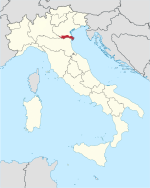Rovigo Province
| Rovigo Province | |
|---|---|

|
|
| State : | Italy |
| Region : | Veneto |
| Area : | 1,789.93 km² ( 79. ) |
| Residents : | 233,386 (Dec. 31, 2019) |
| Population density : | 130 inhabitants / km² |
| Number of municipalities: | 50 |
| License plate : | RO |
| ISO-3166-2 identification : | IT-RO |
| Website: | www.provincia.rovigo.it |
The province of Rovigo (Italian Provincia di Rovigo ) is located in the northern Italian region of Veneto ( Veneto ). It is about 1790 km² and has 233,386 inhabitants in its 50 communities (as of December 31, 2019). The capital is Rovigo .
The province is bordered by the provinces of Venice , Verona and Padua to the north, Lombardy to the west, Emilia-Romagna to the south and the Adriatic Sea to the east . Its geographical expansion largely corresponds to the Polesine landscape . The northern border forms the Adige , the southern the Po . There are numerous drainage canals between the two rivers.
In the area of the province, which is very flat, are the entire Po Delta and the city of Adria , which is said to have given the Adriatic Sea its name. Agriculture supplies wheat , maize , rice , sugar beet , wine, and fruit and vegetables . The constant risk of flooding and flooding led to a strong emigration of the local population, especially during the 1950s and 1960s, which impaired the region's economic development. There are metalworking , textile and food processing industries; the latter includes sugar refineries . There is significant tourism in the coastal cities . The climate is continentally mild with high humidity and has humid summers and foggy winters; Rainfall mostly falls in spring and autumn.
History
The territory of the province of Rovigo was first settled by the ancient Greeks who lived in the 12th to 11th centuries BC. Founded the Adriatic colony . During the 6th and 5th centuries BC Etruscans and Venetians inhabited the area, which the Romans followed. In the Middle Ages , the region was ruled by the House of Este as part of the Duchy of Ferrara , but was not a separate administrative unit of the Duchy. The Estonians pledged the area in 1394 to the Republic of Venice , which gave it back, but conquered it during the War of Ferrara in 1483 and kept it in the peace of 1484. The Venetians called the area territorio , and its capital was Rovigo. For the first time, the region was an administrative unit that can be regarded as the starting point of the province of Rovigo, even if it was smaller than today's province. After the Congress of Vienna (1815), its southern border was extended to the Po and it now belonged to the Kingdom of Lombardy-Veneto . In 1851, the Po delta, which had previously belonged to the province of Venice, finally came to the province of Rovigo, giving it its current size. In 1866 it fell to the Kingdom of Italy .
Largest communities
(As of December 31, 2019)
| local community | Residents |
|---|---|
| Rovigo | 51,049 |
| Adriatic | 19,159 |
| Porto Viro | 14.093 |
| Occhiobello | 12.092 |
| Lendinara | 11,550 |
| Badia Polesine | 10.125 |
| Postage great | 9415 |
| Taglio di Po | 8135 |
| Rosolina | 6294 |
| Villadose | 4929 |
Individual evidence
- ↑ Statistiche demografiche ISTAT. Monthly population statistics of the Istituto Nazionale di Statistica , as of December 31 of 2019.



